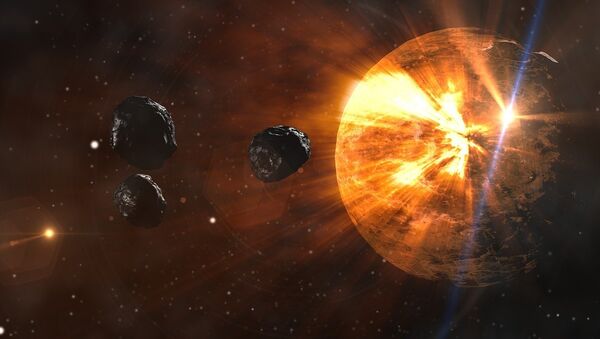In 1998, two blockbuster films, Armageddon and Deep Impact, depicted what a gigantic asteroid collision with Earth would look like. To date, none of us have, luckily, experienced anything similar to what was depicted on the big screen, but we do know that there have been a number of near-collisions with Earth.
We also know that Earth is constantly bombarded with meteors and has been for many-many years.
But how many actually know the difference between an asteroid and meteor?
An asteroid is a large rocky body in space which orbits around the Sun. A meteoroid is a much smaller rock or particle that orbits around the Sun.
On 30 June, ESA experts join scientists, astronauts & (space) rock stars in 24-hour global webcast for #AsteroidDay https://t.co/LJJSQImxNc pic.twitter.com/Um1om9Z7RK
— ESA (@esa) June 29, 2017
If a meteoroid enters the Earth's atmosphere and vaporizes, it becomes a meteor, which is also often called a shooting star.
In celebration of these heavenly — at time dangerous — bodies is a look at five times an asteroid or meteorite almost or did, in fact, hit our home planet.
Tunguska Event
Friday June 30 was picked to commemorate the largest meteorite explosion ever recorded in human history. It took place in 1908 and is known as the Tunguska Event.
A suspected meteorite detonated over the Russian taiga, causing devastation to 800 square miles of forest. The impact was equal to the largest nuke ever detonated by the US.
And there are several weird and wonderful facts about the Tunguska Event.
The effect of the collision was felt in Britain, with a reader writing to the Times paper inquiring why the sky was so bright at night.
The event also influenced popular culture. In 1996 it received one of the true accolades of mysterious happenings — inspiring an episode of the cult TV show The X-Files, and in 2008, Nintendo brought out a Wii game based on the event.
Its international asteroid day!On this day 1908, the Tunguska asteroid hit Russia wiping out an entire forest, 100yrs on still nothing grows pic.twitter.com/jRTlXqE86F
— Dr Maggie Lieu (@Space_Mog) 30 June 2017
Even today, the Tunguska Event remains a complete mystery and its causes continue to be debated.
To cause such a large blast, some scientists determined that the meteor would have weighed around 220 million pounds (110,000 tons) and traveled approximately 33,500 miles per hour before disintegrating. Other scientists say that the meteor would have been much larger, while others say much smaller.
Additional explanations have ranged from the possible to the ludicrous, including a natural gas leak escaped from the ground and exploded, a UFO spaceship crashed, and the effects of a meteor destroyed by a UFO's laser in an attempt to save Earth.
Chesapeake Bay Crater
More than 35 million years ago, a 15-story wall of water triggered by an asteroid strike washed over Virginia from its coast, then located at Richmond.
Yet despite its age, the effects of this ancient asteroid strike, as well as other epic space rock impact scars, can still be felt today, scientists say.
Discovered in the early 1980s, the Chesapeake Bay Crater is located approximately 125 miles (201 kilometers) from Washington, DC.
#COPUOS & @UNOOSA have worked for many years on asteroids/Near Earth Objects (NEOs). Learn more: https://t.co/8qLl1tpHwz #AsteroidDay pic.twitter.com/mSeFwEUHuY
— UNOOSA (@UNOOSA) June 30, 2017
Some estimates suggest this crater is 53 miles (85 kilometers) wide.
Morokweng
In 2006, a large fragment was found in Morokweng, South Africa. The fragment was said to be from an asteroid that had punched a 160 kilometer-wide (100 miles) hole in the Earth's surface.
The initial discovery was made in 1990s, however in 2006, it gained notoriety.
The beach ball-sized fossil meteorite was drilled out of South Africa's 145-million-year-old Morokweng crater.
It is a unique discovery because large objects are widely believed to completely melt or vaporize as they collide with the planet.
The Morokweng crater is one of the largest on Earth, and was formed at the boundary of the Jurassic and Cretaceous periods.
Chicxulub Crater
This asteroid impact is said to have occurred over 65 million years ago in Yucatan, Mexico.
Many scientists believe that the meteorite that left this crater caused or contributed to the extinction of the dinosaurs.
Estimates of its actual diameter range from 106 to 186 miles (170 to 300 kilometers).
Allan Hills
This lump of rock made an impact not just because of its huge size — as it weighted about 170 grams — but because it was said to contain signs of alien life, according to a NASA scientist.
The rock was blown from the surface of Mars about 15 million years ago by a huge asteroid impact and eventually fell in Antarctica about 13,000 years ago.
A thin section of Allan Hills A76009, Antarctica L6 #meteorite viewed in cross polarized light. pic.twitter.com/jXQQrQpjP5
— Peter Scherff (@PeterScherff) May 23, 2017
The researchers who analyzed it, spotted what they thought were the outlines of tiny cells, organic molecules and iron-containing deposits similar to those produced by some bacteria on Earth.
However, since then there have been numerous explanations for this.
Some experts say that it would have been created between 4.5 to 3.8 billion years ago during a time when Mars still had a magnetic field. A further explanation came from the fact that it matched the inferences from earlier orbital photos of valleys and tributaries apparently carved by water when the Martian climate was wetter and warmer, which scientists believe could explain the molecules and iron-containing deposits found.


